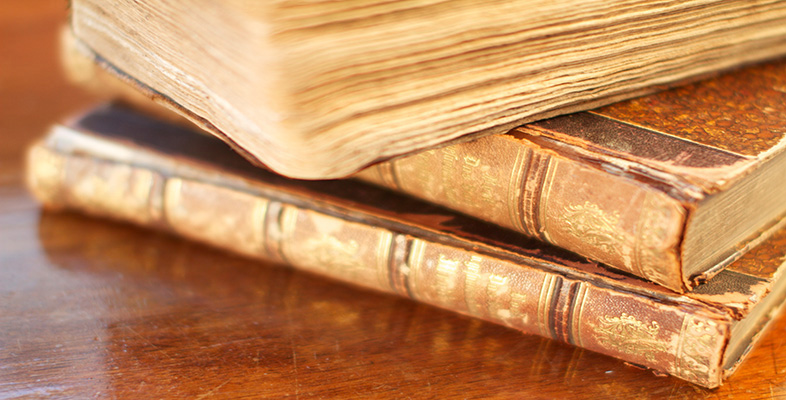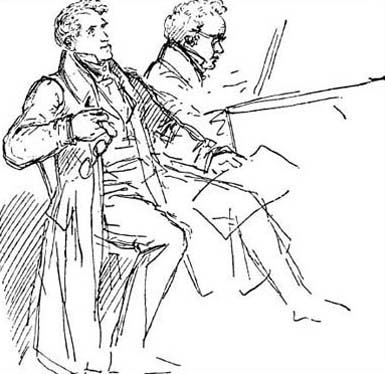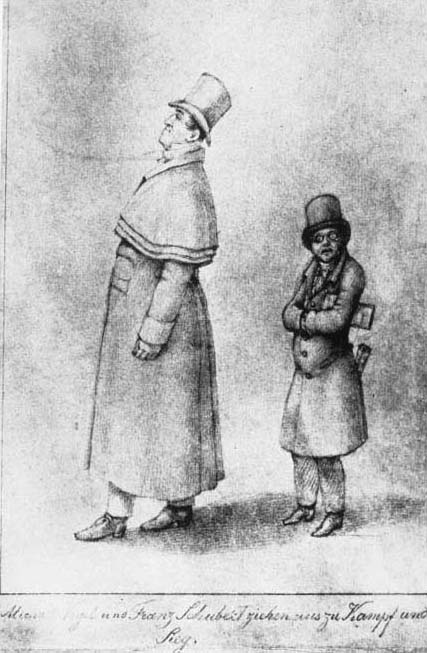2.2 Schubert and Johann Michael Vogl
By 1825 Schubert's painter friend Moritz von Schwind was reporting, ‘There is a Schubertiad at Enderes's each week – that is to say, Vogl sings’ (quoted in Deutsch, 1946, p. 401). Schwind names seven regular male members of the group, so even allowing for wives and other unnamed friends it was quite a small gathering. Another report of a Schubertiad at Enderes's the following year mentions that ‘more than 20 people have been asked’ (quoted in Deutsch, 1946, p. 531), and several other gatherings were of similar size. The musical part of the evening was always followed by food and drink, and sometimes dancing, for which Schubert often played the piano. Afterwards some of the group would go on to an inn.
Johann Michael Vogl (1768–1840), mentioned above by Schwind, was a key figure in the success of Schubert's songs on such occasions. Vogl was a celebrated baritone at the Vienna Court Opera who met Schubert for the first time in 1817. He was aged 49, and reaching the end of a successful operatic career. He was renowned for his performances in both Italian and German opera, and three years earlier he had taken part in the premiere of Beethoven's Fidelio. Through the intervention of a friend, Vogl was persuaded to come to Schubert's lodgings to try some of his songs. Vogl sang three songs, including ‘Ganymed’, which Schubert had only just completed. His manner was haughty, and Schubert, as an unknown composer, was somewhat in awe of him. But Vogl was impressed, and soon became a great advocate of Schubert's Lieder, frequently performing them at private and public concerts, often accompanied by Schubert himself – though, since Schubert was not a pianist of the first rank, also by professional pianists on the more public occasions. Despite Vogl's grand manner, he and Schubert became friends. Several times they travelled together during the summer, and Schubert stayed with Vogl on visits to the singer's birthplace, Steyr in Upper Austria. On one trip in 1825, they travelled back via Salzburg, staying at a number of houses on the way and performing to private gatherings.
Schubert wrote a long letter to his brother Ferdinand describing this trip. At Salzburg:
Through Herr Pauernfeind, a merchant well known to Herr von Vogl, we were introduced to Count von Platz, president of the assizes, by whose family we were most kindly received, our names being already known to them. Vogl sang some of my songs, whereupon we were invited for the following evening and requested to produce our odds and ends before a select circle; and indeed they touched them all very much, special preference being given to the ‘Ave Maria’ already mentioned in my first letter. The manner in which Vogl sings and the way I accompany, as though we were one at such a moment, is something quite new and unheard-of for these people.
(Quoted in Deutsch, 1946, pp. 457–8)
This was a partnership important to both of them: it did a great deal to spread Schubert's name as a song composer, and it gave Vogl a second career when he was too old to continue on the opera stage. Ironically, Vogl, already famous in his own lifetime, is now remembered only because of this later association with Schubert.
As Schubert's letter shows, he was delighted with the way Vogl performed his songs. Other writers confirm that he sang with mastery, but sometimes suggest a somewhat conceited and affected manner, as in the following two descriptions:
On 11th November [1823] we had a Schubertiad at home, at which Vogl took over the singing … V was much pleased with himself, and sang gloriously; we others were merry and bright at table …
(Quoted in Deutsch, 1946, p. 302)
Vogl sang Schubert's songs with mastery, but not without dandyism.
(Quoted in Deutsch, 1946, p. 573)
Vogl had a habit of elaborating Schubert's vocal lines, as his surviving copies of the songs confirm. Nowadays, this would be considered shocking, though there is no report that Schubert objected to such liberties, and it is quite possible that this was a general habit among singers of the day. And he had a somewhat mannered habit of playing with his glasses while singing. But he was undoubtedly an important agent in getting Schubert's songs known, and he devoted much of his time to them once he had retired from the operatic stage. In 1823 (two years after Vogl's retirement), Schubert wrote in a letter: ‘He is taken up with my songs almost exclusively. He writes out the voice-part himself and, so to speak, lives on it’ (quoted in Deutsch, 1946, p. 301).
Exercise 2
Click to open Plate 1: Moritz von Schwind, “An Evening at Josef von Spaun’s: Schubert at the Piano with the Operatic Baritone Johann Michael Vogl [Tip: hold Ctrl and click a link to open it in a new tab. (Hide tip)] ”, 1868, sepia drawing, Historisches Museum der Stadt Wien. Photo: Bridgeman Art Library
Plate 1 (above) is a famous sepia drawing by Moritz von Schwind, a painter who was a close friend of Schubert. It shows a Schubertiad at the house of Josef von Spaun. It was inspired by a particular evening on 15 December 1826, at which Schubert and Vogl performed more than 30 of Schubert's songs, but was not drawn until 1868. It shows Schubert at the piano, with Vogl sitting beside him performing one of his songs. Figure 2 is a sketch of Vogl and Schubert also by Schwind, one of several preliminary studies for the complete drawing. Figure 3 is a caricature drawing of Vogl and Schubert, with the description, ‘Michael Vogl and Franz Schubert setting out to fight and to conquer’. It was drawn in about 1825, possibly by Franz von Schober, the friend who first introduced Vogl and Schubert in 1817.
Study these three illustrations, and read the following contemporary description of the same gathering, written by Franz von Hartmann, one of those who attended. What do these different pieces of evidence suggest to you about the relationship between Vogl and Schubert, their audience, and the character of a Schubertiad compared with a modern concert?
15th December 1826: I went to Spaun's, where there was a big, big, Schubertiad. On entering I was received rudely by Fritz and very saucily by Haas. There was a huge gathering. The Arneth, Witteczek, Kurzrock and Pompe couples, the mother-in-law of the Court and State Chancellery probationer Witteczek: Dr. Watteroth's widow, Betty Wanderer, and the painter Kupelwieser with his wife, Grillparzer, Schober, Schwind, Mayrhofer and his landlord Huber, tall Huber, Derffel, Bauernfeld, Gahy (who played gloriously d quatre mains [i.e. piano duets] with Schubert) and Vogl, who sang almost 30 splendid songs. Baron Schlechta and the other Court probationers and secretaries were also there. I was moved almost to tears, being in a particularly excited state of mind to-day, by the trio of the fifth March [Op.40 No.5, a funeral march for piano duet], which always reminds me of my dear, good mother. When the music was done, there was grand feeding and then dancing. But I was not at all in a courting mood. I danced twice with Betty and once with each of the Witteczek, Kurzrock and Pompe ladies. At 12.30, after a cordial parting with the Spauns and Enderes, we saw Betty home and went to the “Anchor”, ‘,where we still found Schober, Schubert, Schwind, Derffel and Bauernfeld. Merry. Then home. To bed at 1 o'clock.
(Quoted in Deutsch, 1946, pp. 571–2)
Discussion
The main differences between this Schubertiad and a modern concert performance are obvious enough from the sepia drawing: the audience is small and crammed together very close to the performers. Most of the women are sitting in the front (there are three peering through the doorway on the left), and most of the men are standing behind them. It was an intimate, social occasion compared with most modern performances of Schubert's songs. It is important to remember, however, that the drawing was not done until 42 years after the event. It has a rather stylised appearance, with many of the figures drawn with exaggeratedly emotional poses. Vogl himself gazes at the ceiling, with his chest puffed out, and one hand extended towards the music on the piano, the other holding his glasses. The sketch is much more lively and down-to-earth, as sketches often are. Vogl sits in a more natural way, looking straight ahead, not at the ceiling. In one hand he holds his glasses, as in the finished drawing, but in the other he holds a single sheet of music, rather than extending his arm towards the music on the piano. Since Schubert, in the letter quoted earlier, describes Vogl as writing out the voice-parts of the songs, this is presumably the voice-part of the song he is singing.
In both the finished drawing and the sketch, Vogl is seated to sing, not standing as in the modern concert hall. This suggests not only a less formal relationship between performer and audience than we are used to, but also a more intimate style of performance than that of the modern Lieder singer. There is good evidence that the big, dramatic voices that modern singers are trained to produce are far larger in volume than the voices of the early nineteenth century were. Modern voices have been trained to carry in large opera houses and concert halls, and to be heard over the modern orchestra. In Schubert's day, orchestras were smaller, instruments (including the piano) were quieter than their modern counterparts, and voices had less to compete against. Vogl's singing was probably on a much smaller scale than most of the singing of Lieder to be heard today.
However, Figure 3 certainly suggests that Vogl was a character with a grand manner, as also do some of the descriptions of him. It caricatures the contrast between Vogl, the operatic star, and Schubert, the somewhat shy, diminutive and chubby composer. (His height was 157cm, less than 5ft 2ins, and he was known to his friends as ‘Schwammerl’, a kind of small mushroom.)
Hartmann's description of this Schubertiad makes it clear that the invited guests consisted of a mixture of musicians and artists together with prominent members of the middle classes and a smattering of minor nobility: lawyers, senior civil servants, and a baron. These were the people whose interest had to be aroused, and whose financial help had to be gained, if a composer was to succeed in Vienna in the early years of the nineteenth century.
Plate 2 (below) shows a smaller gathering at the castle owned by Franz von Schober's family at Atzenbrugg, 40 kilometres from Vienna. Schober was a lawyer, and an important member of Schubert's group of friends. It was at Schober's home in Vienna that the first reported Schubertiad (described earlier) took place. Schubert stayed at the Schober family castle three summers in succession (1820–2) and this watercolour by another friend, Leopold Kupelwieser, dates from that period. It was Schober who introduced Vogl to Schubert, and he was himself described as rather a theatrical character. Kupelwieser's painting shows a game of charades being played. Schubert is seated at the piano, a dog by his side. He is reported to have improvised music for his friend's entertainments and dancing on such occasions.
Clickto open plate 2: Leopold Kupelwieser, “The Family of Franz von Schober playing Charades”, 1821, watercolour, Historisches Museum der Stadt Wien. Photo: Bridgeman Art Library


